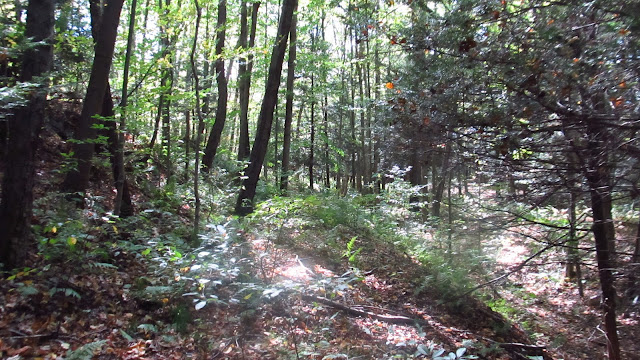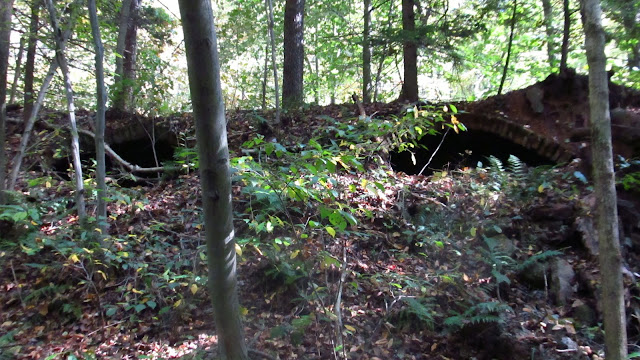Last weekend we took a wonderful camping trip to Prince Gallitzin State Park. While we were there, we took a walk down the tracks south of Frugality to check out some coke ovens I had seen on an old mine map. I spent the better part of this week trying to figure out what we had. Initially, I mistakenly had them pegged as the Amsbury Coke Works, but I located those several miles to the south. That will be a nice winter trip!
It turns out my Dean's ran together. Last year Lou and me took a trip out to the Dean No. 8 Coke Works on State Game Lands near Fallentimber. The history I traced for Dean No. 8, pre-1897, is actually the history of Dean No. 9. There is one map showing the ovens at Dean No. 9. It clearly identifies 88 ovens in two "single blocks of ovens". One "block" contained 38, the other contained 50. The bank of 38 ovens is gone. These ovens were most likely decimated when Route 53 was put in. The remaining ovens, toward the middle, run almost directly below Route 53. The ovens themselves are in pretty bad condition. None of the fronts are extent, but there are some large blocks and stones remaining onsite. The ovens most likely collapsed on their own, burying themselves in their own rubble. This would make a unique industrial archaeology site. What remains are typical of the countless other coke plant sites scattered around Southwestern and Central Pennsylvania.
Initially, my confusion started simply as a result of the numbering of the coke plants. Dean No. 9 came before Dean No. 8. Had I been there, I would have said "number these different, you're going to drive somebody insane in 130 years", but I wasn't. It took a couple years, but I think I have it now.
Dean No. 9 Mine and Coke Works began operating in 1887 under the name Rubino Coke Works. The first year that they are listed in the mining reports (1887) they are labeled as Rubus, but this was most likely a misprint. They are listed as having 88 ovens and being operated by the Cresson and Clearfield Coal and Coke Company. Cresson and Clearfield would operate these ovens for pretty much the extent of their existence. The coke plant would be known as Rubino until 1891, and that's when the Dean label would be attached.
In 1892, the plant was renamed Dean No. 4 (this irons out the numbering confusion). This plant was known as Dean No. 4 until 1898, when it was named Frugality No. 4, operated by the Frugality Coke Company. This name change would only last one year however. From 1899, until it simply disappears in 1911, it would be Dean No. 9, operated by the Cresson and Clearfield Coal and Coke Company.
Simply disappearing is putting it rather bluntly. This mine and coke works was gasping for life for seven years. In 1903, it was listed as abandoned, but it continued to list 88 ovens. In 1904, it was reopened.
 |
1904 report of the Department of Mines of Pennsylvania, showing the status of Dean No. 9. |
From 1905-1907 all 88 ovens would be listed, but the coal output of the mine was very minimal (27,212 tons in 1907, vs. 82,395 in 1895). 1908 would see Dean No. 9 employing 9 men and using 16 ovens. In 1909, they were down to 12 ovens, and after that there would be no mention of Dean No. 9 until 1912 when it was listed as idle. That would be the end of it.
 |
The extent of what remains at Dean No. 9. |
 |
Off of the spur from the tracks, there are excellent examples of the loading piers still remaining. Another reason this would make an interesting archaeological site. |
 |
The end of the 50 oven bank. |
 |
A great example of how a coke oven gradually gets torn apart. |
 |
The tracks heading south from Frugality have not been used in a while. |
 |
A view of Glendale Lake from Headache Hill in Prince Gallitzin State Park. |






















No comments:
Post a Comment